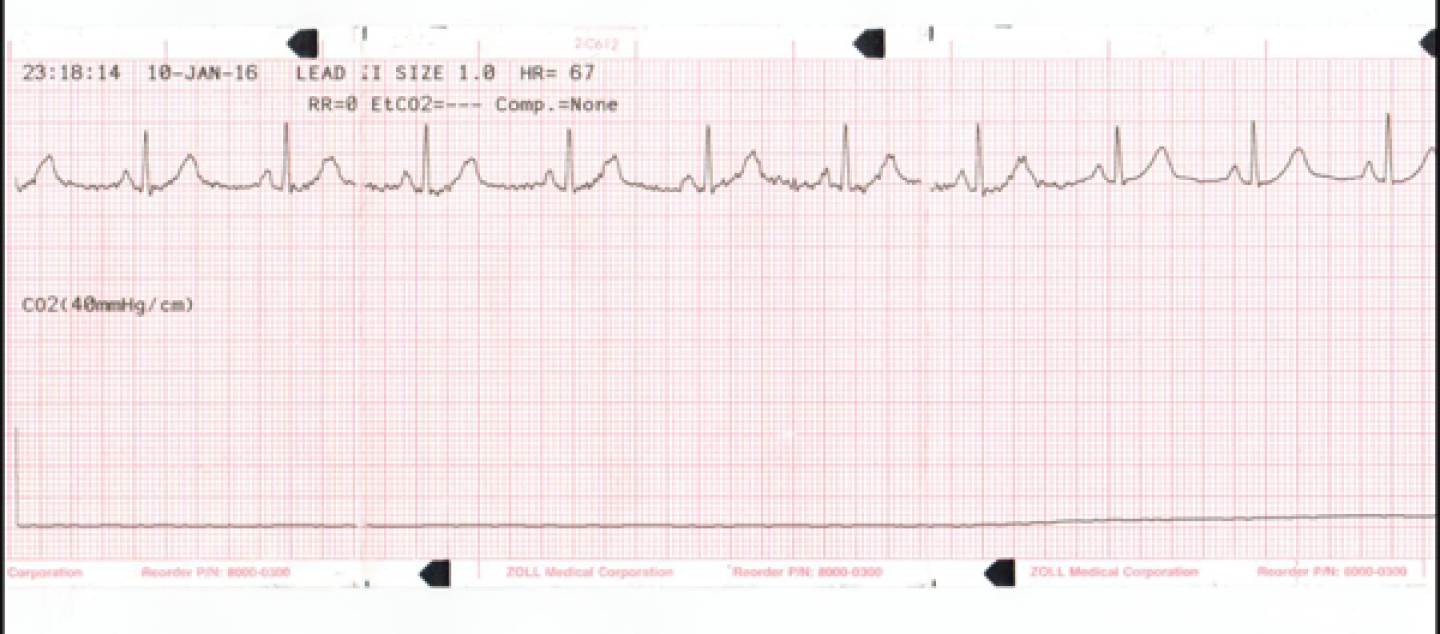A 56-year-old male collapsed at a restaurant and received several minutes of dispatcher-assisted CPR. A civilian responding to a mobile phone alerting system retrieved an AED from an adjacent business and administered one shock prior to arrival of EMS.
Initial assessment revealed the morbidly obese patient had a pulse and blood pressure but was unresponsive and apneic. Bag-valve-mask ventilations were difficult due to the patient’s size, so the ALS transport crew elected to intubate. After two unsuccessful oral endotracheal intubation attempts, a King LT-D supraglottic airway was inserted and manual ventilation was continued.
Consistent with protocol, waveform capnography was attached; the following tracing was obtained.
The ALS providers believed the supraglottic airway was placed properly. They theorized that the zero value ETCO2 and absence of a discernable capnography waveform resulted from the use of monitoring equipment designed for endotracheal tubes with an alternative (supraglottic) airway.
In fact, the supraglottic airway was not in place; the patient shortly thereafter became bradycardic, rearrested and subsequently died.
Comparing waveforms from different airway adjuncts
There are some studies that compare ETCO2 waveforms and measurements obtained from endotracheally intubated patients to those using supraglottic or other alternative airways. In the mid 1990s, supraglottic airways began to gain popularity as an alternative to endotracheal intubation for short duration surgical procedures requiring general anesthesia.
In that era, multiple papers were published comparing capnography waveforms and values obtained from multiple types of airways and using a wide variety of ventilation modes. It was during that same period when comparisons were made using nasal cannula derived end-tidal values.
Those studies established two findings unequivocally. First, ETCO2 values obtained from measurements made in-line with any airway device, including bag-valve-mask devices and nasal cannulas, are equivalent to those obtained from an endotracheal tube. Second, waveforms obtained from any airway device, including BVMs and nasal cannulas, are identical to those obtained from an endotracheal tube.
The implications of these earlier and innumerable studies from the anesthesia world were significant. Capnography was a safe and reliable means of assessing the adequacy of ventilation in endotracheally intubated patients, of patients being ventilated with all types of airways and of patients being ventilated with no airway adjuncts at all.
Research studies also demonstrated that capnographic waveforms could be used with alternative airways to evaluate a wide variety of conditions such as cuff leaks, ventilator dyssychrony, bronchospasm, air trapping and low cardiac output with equal efficacy regardless of the type of airway they were attached to. These findings should not be lost on EMS.
There are no differences
While there remain some questions about proper sampling and use of capnography in certain high-flow gas therapies such as jet ventilation in neonates and high-flow nasal cannula therapy for adults, neither of these therapies are currently used by EMS.
Continuous waveform capnography is an EMS standard of care and must be used to monitor placement and adequacy of ventilation with any artificial airway. The voluminous anesthesia and prehospital literature tells us that the waveforms and values obtained from any alternative airway will be identical to those obtained from an endotracheal tube.
There are no differences. If you place supraglottic airways and fail to see a four-phase capnographic waveform, the airway is not in place and ventilation is not occurring.
The incidence of misplaced supraglottic airways may not be low nor is the number of ALS providers who mistakenly attribute lack of a clearly observable capnography waveform to use of an alternative airway. An abstract presented in January by Vithalani et al, reported a 13.9 percent incidence of unrecognized misplaced King airways by paramedics in a large urban 911 EMS system.
ETCO2 is irrefutable indication of airway placement and ventilation
There are many reasons why an alternative airway may not be properly placed, some related to operator error and some to variations in patient anatomy.
Regardless of why, the absence of a clearly discernable four-phase capnography waveform and the presence of measureable CO2 is a clear and irrefutable indication that the airway is not in place and ventilation is not occurring.
Finally, EMS providers should use capnography waveforms obtained during ventilation — regardless of the type of airway in place — to assess the effectiveness of ventilation and troubleshoot airway and ventilatory issues such as cuff leaks, air trapping, airway resistance and dyssychrony.
References reviewed:
- Gottschalk A, Mirza N, Weinstein GS, Edwards MW. Capnography during jet ventilation for laryngoscopy. Anesth Analg. 1997;85:155-159.
- Chhibber AK, Kolano JW, Roberts WA. Relationship between end-tidal and arterial carbon dioxide with laryngeal mask airways and endotracheal tubes in children. Anesth Analg. 1996;82:247-250.
- Chhibber AK, Fickling K, Kolano JW, Roberts WA. Comparison of end-tidal and arterial carbon dioxide in infants using laryngeal mask airway and endotracheal tube. Anesth Analg. 1997;84:51-53.
- Fukuda K, Ichinohe T, Kaneko Y. Is measurement of end-tidal CO2 through a nasal cannula reliable? Anesth Prog. 1997;44:23-26.
- Lee JS, Nam SB, Chang CH, Han DW, Lee YW, Shin CS. Relationship between arterial and end-tidal carbon dioxide pressures during anesthesia using a laryngeal tube. Acta Anaesthesiologica Scandinavica. 2005;49: 759-762.
- Casati A, Fanelli G, Cappelleri G, Albertin A, Anelati D, Magistris L, Torri G. Arterial to end-tidal carbon dioxide tension difference in anaesthetized adults mechanically ventilated via a laryngeal mask or a cuffed oropharyngeal airway. Eur J Anaesthesiol. 1999;16:534-538.
- Freeman JF, Ciarallo C, Rappaport L, Mandt M, Bajaj L. Use of capnographs to assess quality of pediatric ventilation with 3 different airway modalities.
- Vithalani VD, Richmond N, Davis SQ, Hejl L, Howerton D, Gleason W, Emergency Physicians Advisory Board, MedStar Mobile Healthcare. Unrecognized failed airway management using a blind-insertion supraglottic device. Abstracts for the 2016 NAEMSP Scientific Assembly. Prehospital Emergency Care. 2016;20:144.




